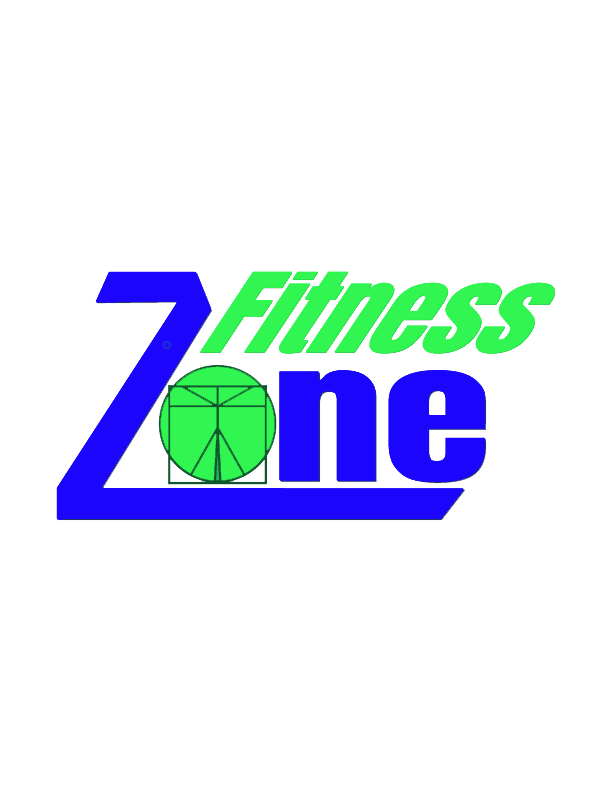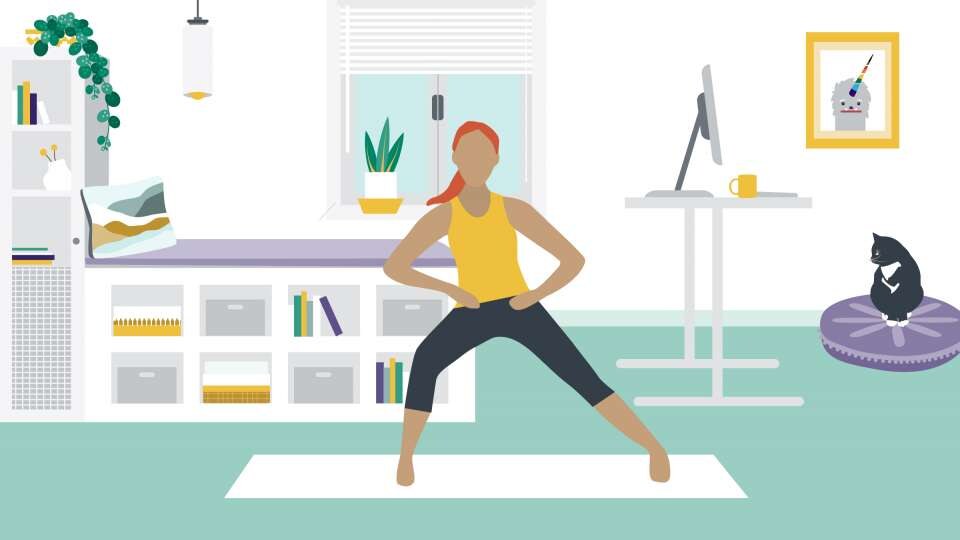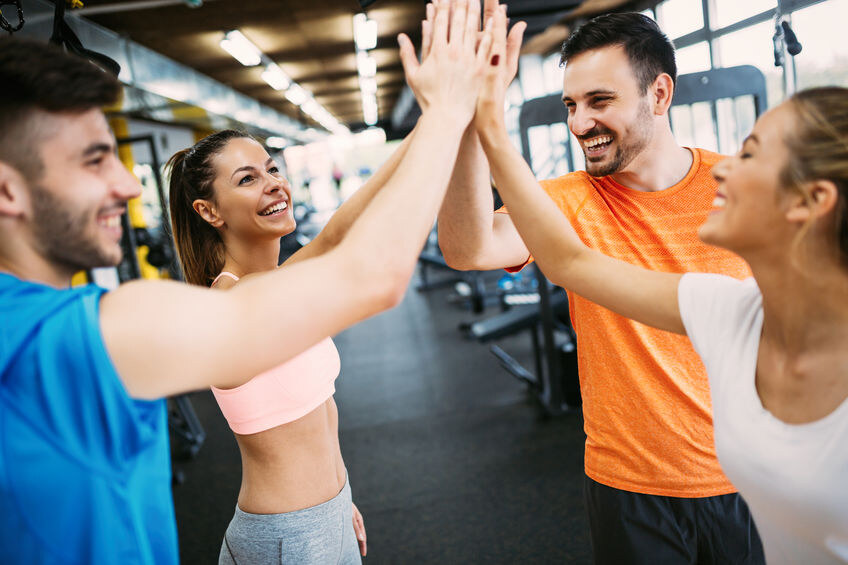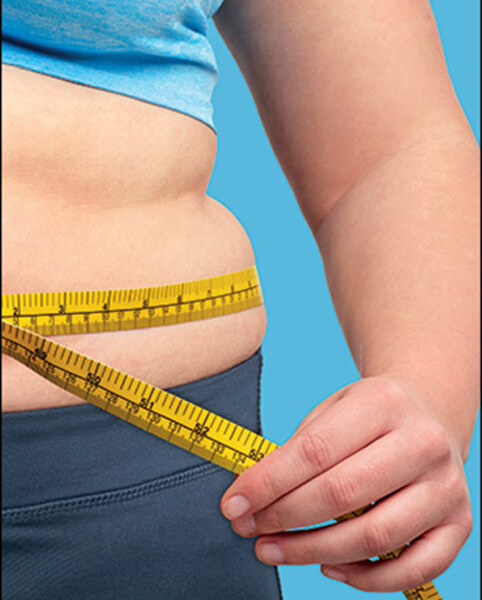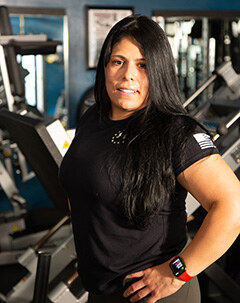Top 10 fitness Questions answered
Many people have fitness questions about their workouts and fitness. Whether broad questions or more advanced, here are some of the most common fitness questions answered for you!
Should I work out every day?
Believe it or not, working out every day is not necessary to see progress, with many experts suggesting that workout routines add a rest day or two to help prevent soreness and give the body more time to recover- even helping to prevent injury. That said, it is important to keep light exercise even on rest days, whether just a quick walk around the neighborhood or a few simple stretches.
How long can I stick to the same routine?
You may wonder, “Why fix what’s not broken?”, however, it is important to mix up your routine for a variety of reasons. Primarily, it can help prevent your body from getting used to the same routine and prevent stalls in progress. In addition, it is often good to re-evaluate your goals and adjust your routine so that you see results where you want to the most.
Is there a “best” type of diet to follow to see results?
Much like there is not a one-size-fits-all workout routine, the best diet for your goals might be different from that of another. It is important to research what types of diets work best for you and your goals or consult with a professional that can help you evaluate your individual needs.
I don’t want to become too bulky- do I need to do muscle training?
Most people who bulk up work extremely hard to gain their musculature, so there is no need to worry about doing so accidentally! Muscle training is good for people with various goals and should be incorporated in some capacity to make a well-rounded routine.
I want to lose weight quickly- what workouts are best for me?
Cardio workouts, particularly those that have a high-calorie burn rate, are the best for weight loss. However, be warned that weight loss requires changes to both diet and exercise to be successful.
What is the best way to deal with sore muscles?
Relaxing in a warm bath with Epsom salts, using a foam roller to gently massage muscles, and using a heating pad are surefire ways to ward off soreness. A good night’s rest is also an excellent way to help you recover!
How long should my work out last?
While time spent working out will vary based on your goals and needs, typically at least 30 minutes is a good goal post with an hour being closer to ideal.
How long do I need to wait to see results?
Typically, 6 –8 weeks (about 2 months) is when you’ll typically begin to notice results, although the extent of the results will often vary based on your particular routine, how closely you stick to it, and the degree of intensity you subscribe to. However, it’s important to focus on long-term sustainable changes, so be prepared for it to be a longer work in progress!
How intense should my workouts be?
While at least moderate intensity is probably the best, any increase in activity can provide benefits. Routines should be adjusted as needed- but it doesn’t necessarily hurt to start small and increase intensity as time goes on.
What is the best way to evaluate my needs?
Often, whether establishing new goals or updating old ones, it is good to check in with your current routine and diet to see whether they still support your current goals, or how they may be adjusted to suit new ones. It may benefit you to have an unbiased, educated third party, such as a personal trainer, assist with this sort of evaluation as they can give more specific insights tailored to your situation.
Have more questions or want specially tailored advice to suit your fitness needs? Consider setting an appointment with one of our certified personal trainers today at (843) 663-3900.
Warm up: A Smart start to your workout
- Warming up before exercise increases blood flow to your muscles and raises your body temperature.
- This can improve your performance and decrease your risk of injury.
- To warm up before you work out, do low-intensity exercise for five to 10 minutes.
- Try activities like walking, jogging or jumping jacks.
- Instead of static stretches, do dynamic stretches, which get your body moving.
This winter, whether you’re determined to workout outside even when it’s freezing or want to stick to the comfort of your at-home gym (aka your living room, bedroom or garage), there’s one important step before you start: your warmup.
Dr. Alison Putnam, a physician at the Sports Medicine Clinic at Ballard, explains how to effectively warm up for exercise — and why it’s so important to get your muscles warm before you work out.
How to warm up
While “warming up” might incite thoughts of reheating leftovers in the microwave, it also refers to getting your body ready for exercise.
“When you warm up, you’re working on improving blood flow to muscles and warming up muscle tissue,” says Putnam. “You usually want to do some form of low-intensity work that prepares you for the exercise you’re going to do.”
For instance, if you’re planning on going for a run, a low-intensity exercise that would properly warm you up is a slow jog. If you’re doing a strength workout such as weightlifting or Pilates, start with some jumping jacks to increase the blood flow to your muscles.
Other low-intensity warmups include going for a quick walk, pedaling on a bike, doing a few pushups or moving through some yoga poses.
Think of your warmup activity as movement that sightly elevates your heart rate and gets you working up a light sweat (as my favorite workout instructor calls it, “that glazed doughnut look”).
“Aim to warm up for around five to 10 minutes before you start your workout,” adds Putnam.
The dos and don’ts of stretching
If you were taught to do static stretches — where you sit and hold a stretch for what feels like minutes on end — before working out, try dynamic stretching instead.
“Static stretches are not helpful before you work out,” says Putnam. “Dynamic stretching is better for warming up because it’s a stretch that involves motion.”
Three dynamic stretches that she suggests incorporating into your warmup routine:
Hamstring. To loosen up the back of your legs, stand with your feet on the ground and hinge at your hips, slowly bending over and then standing back up. Your legs should be straight, but don’t lock your knees.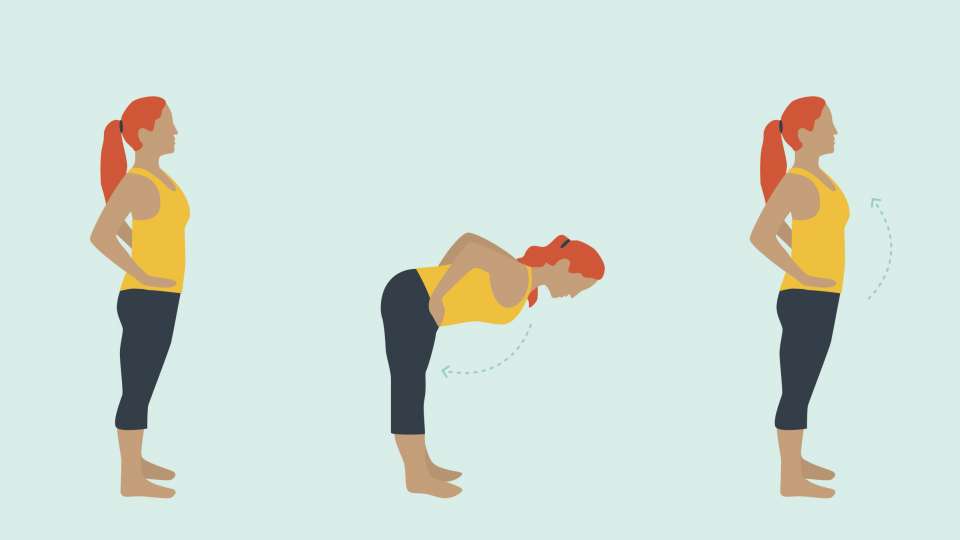
Adductor. To loosen up the inside of your legs, walk your feet out into a wide stance with your feet facing forward and slowly lunge from side to side. Your knee should not go past your toes each time you lunge.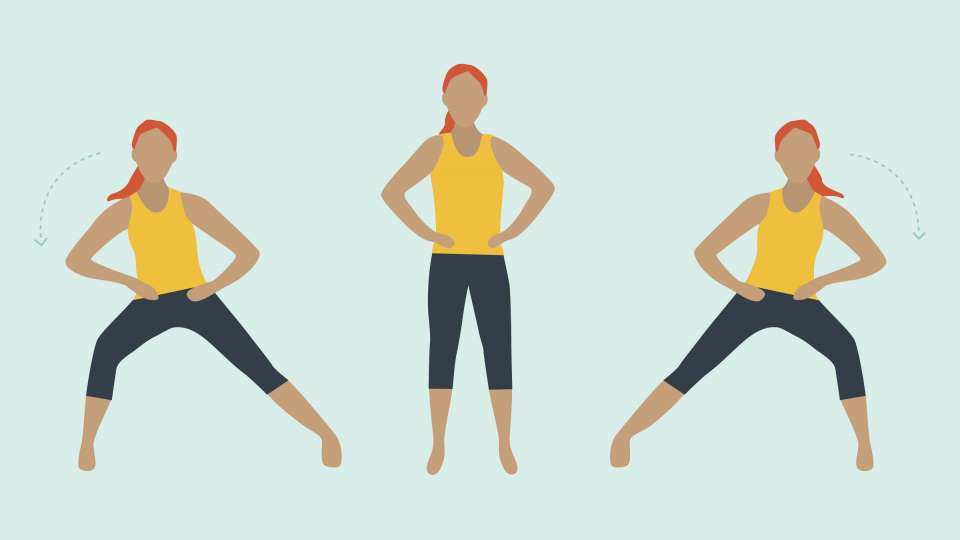
Chest and arms. To warm up your arm and chest muscles, grasp your hands behind your back and while keeping your arms straight, slowly raise your clasped hands up and back down. If you can’t reach your hands, use a strap to connect your hands behind your back. 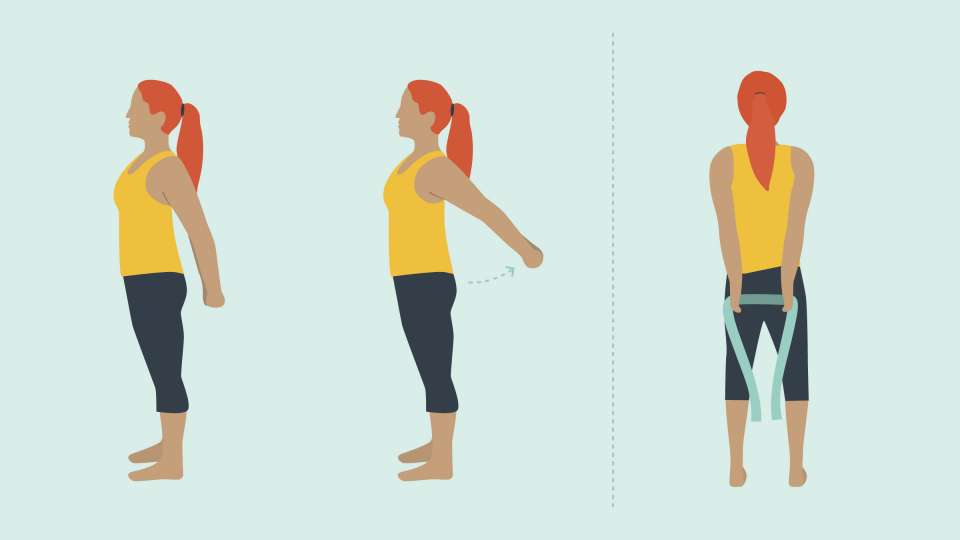
Do each dynamic stretch for 30-60 seconds. Then, do some low-intensity work for a few minutes and get going on your workout.
Why warming up is important
The benefits of warming up go far beyond looking like a glazed doughnut.
“Increasing your blood flow and the temperature of your muscles can increase your range of motion and decrease stiffness, which we think can contribute to decreased injury,” says Putnam.
While results from studies that look at whether or not warming up reduces the risk of injury are somewhat inconclusive, the majority of evidence is in favor of warming up before exercise to decrease the risk of injury.
And with good reason: Jumping (literally) right into your workout without warming up your muscles is like trying to stretch a frozen rubber band. It’s more likely to snap or break, whereas a warm rubber band is stretchy and flexible.
“We also think that warming up can improve your performance,” adds Putnam.
Studies show that elevating your body temperature during a warmup increases the sensitivity of nerve receptors as well as the speed of nerve impulses. In other words, it gets your whole body — mind, muscles, nerves — turned on so that you’re ready to go and give it your best during your workout.
On top of all that, Putnam notes how a good warmup and workout can improve your mental health, too.
“Warming up and exercise in general increases your relaxation and concentration, which is helpful — especially during a pandemic.”
Even more reason to include a warmup before your next workout
10 Commandments of Fatherly Fitness
Once upon a time I was a badass. Ran a sub-six-minute mile. Benched over 300. Competed in kickboxing and jiujitsu and won. I was high speed, low drag, and aerodynamically efficient. But that was once upon a time.
Being a grownup changed all that. More hands on my time left less time for the gym. A body in its 40s doesn’t build muscle or burn fat like the one I had two decades ago. My joints hurt more. Everything takes longer to recover from.
But that’s no reason to give up on fitness. Study after study, after study demonstrate that our bodies are a “use it or lose it” situation. The longer we stay active, the longer we remain able to stay active.
In the vein of “I make mistakes so you don’t have to,” here are 10 commandments of fitness for men as they enter middle age. If you follow them, your body will thank you well into retirement.
1. Thou shalt not skip the fitness warmup
As we age, our muscles and tendons become less flexible and more subject to injury. A solid 10- to 15-minute warmup of light motion (not static stretching, which can actually cause damage when done cold) helps counteract that unavoidable truth. It’s time to start thinking of the warmup not as a thing you do before the workout, but rather the first part of the workout.
2. Thou shalt not be too busy for fitness
Middle age is a demanding time. Kids, a spouse, a job, your community, and maybe a minute for a hobby conspire to leave very few hours in the day for you to spend on fitness. But you have to make it happen. Here are a couple of strong options:
- Exercise early in the morning, before things go wrong with your day that could impinge on your workout time.
- Make exercise a necessary part of your daily routine. For example, bicycle to work.
- Exercise with your family (I do jiujitsu with my son) to combine quality time with exercise.
- Find a workout buddy who will harass you into showing up even when it’s hard.
3. Thou shalt focus on flexibility
Flexible muscles and resilient joints will prevent you from sustaining a sidelining injury you may not fully recover from. The best way to insure them is to build in a cooldown stretching routine lasting 10 to 20 minutes at the end of your workout. Stretching while muscles are warm is a flexibility-force multiplier. Take advantage of it.
4. Thou shalt not ignore it
Two advantages of being a grown adult are (often) having decent health insurance and being old enough that your doctor will listen to you. If you experience pain, go get it checked out. The days of “walking it off” or “no pain, no gain” are behind us, gents. Pain is instead a warning that we’re about to get broken.
5. Thou shalt shift your fitness workouts
Those manly, crazy workouts of our 20s are no good anymore. One-rep maxes, rounds in the right, lifting tractor tires like Rocky are still within our capacity, but we pay for them with soreness and injuries.
Instead, focus on medium-weight, medium-rep exercises with large ranges of motion. Good calls include:
- kettlebells
- yoga
- barbell exercises
- swimming
- certain martial arts
These exercises produce exactly the kind of strength and flexibility your older body needs.
6. Thou shalt not prove it
Whatever your exercise, it’s going to happen. Some 20-something who’s almost as good as you used to be is going to be in class, on the gym floor, or in the next lane over. You’ll be overcome with the impulse to show that you’ve still “got it.” And you might even win.
But you up your chances of injury exponentially when you do so. Even if you get away clean, your muscles will be sore and fatigued for as much as a week afterward, which limits how good your next few workouts can be.
7. Thou shalt put fitness competition behind you
Friendly contests are fine, but resist the urge to enter into serious athletic competitions. It’s simply asking for injury.
This commandment is a corollary to the one directly above, because competition forces you to prove it. Even if you’re in a “master’s league” or similar division, you’ll still be driven to make your body do things it shouldn’t. If you have to compete, look to lower-impact sports, like curling and fun runs.
8. Thou shalt not listen to ‘Glory Days’ by Bruce Springsteen
You know what I mean. Listen all you want, but don’t reminisce too hard about the athlete you used to be.
The best-case outcome is you spend a little time mildly depressed about how your body is now past its peak. The worst case is that the thoughts lead you to put one plate too many on the bar and you get yourself hurt. Stay mindful and celebratory of the present.
9. Thou shalt mind your own damn bucket
There’s an old Zen parable about a monk getting frustrated about how much another monk is able to do while filling buckets with water. The moral is the monk should only focus on what he was able to do, not compare it to the accomplishments of others.
Sure, there are 80-year-olds still benching 400 and finishing an Ironman, but that’s got nothing to do with you. Stay active, stay healthy, and only compare yourself against the goals you’ve set for you.
10. Thou shalt mind what goes into your body, too
No, you don’t have to deprive yourself of all earthly delights to stay fit and healthy. But fueling your 40-plus bod with the right balance of whole grains, protein, veggies, and fruits can help keep you energized and strong. Be sure you’re getting enough of the right nutrients, whether from food, protein powders, or supplements.
From one aging jock to another, I recommend following these rules. They won’t all apply to every man out there, but give each and every one some committed thought.
As the number of candles on our birthday cakes grow, so does the number of times someone reassures us that “40 is the new 20.”
It’s entirely possible to look and feel great at any age. But if you don’t meet some arbitrary beauty standard, there’s no need to feel guilty. These workout tips will help you stay healthy after 40.
Everyone’s journeys are different, and sometimes an injury, illness, or even just life can get in the way of us feeling like we’re the best versions of ourselves.
That’s not only OK, but common — and almost always fixable.
As women get older, we’re more susceptible to illnesses and chronic pain, including heart disease and osteoporosis. Though moving around may be the last thing you want to do when you’re feeling down, inactivity increases the riskTrusted Source of chronic disease.
A little under 23 percent of U.S. adults ages 18 to 64 are getting the recommended amount of exercise per week, and 28 percent over age 50 are physically inactive.
Sometimes age becomes a reason people feel they shouldn’t bother working out.
“[People say,] ‘Oh, I shouldn’t lift weights because I’m too old,’” or “You do need cardio and some resistance exercise.”
But age doesn’t need to be a barrier.
There are so many factors that go into our age, and chronology is the least of it, you can be extremely fit at any chronological age if you train consistently and intelligently. If you’re over 40 and looking to start or intensify your workout routine, try these simple tips.
Go easy on yourself
Society often asks women to wear several hats. Women are more likely than men to care for aging relatives, while also making up about half of the workforce.
Working out every day can feel like a mix of a luxury and another item on an already long to-do list for a busy woman.
You don’t need to work out for hours on end every day.
Try brisk walking for 30 minutes a day, 5 days per week. If you have less time but can do more intense exercises, such as jogging or running, the CDC saysTrusted Source 75 minutes per week is sufficient. That’s only 15 minutes per day!
It’s important to gauge your intensity if you want to reap the heart-healthy benefits of exercise.
The American Heart Association says target heart rates vary by age.
If you don’t have a heart rate monitor, a simple pulse check will let you know where you stand.
Count the beats for 6 seconds and multiply that number by 10. For example, count your pulse when you train for 6 seconds. If it’s 16, you multiply it by 10, and your pulse is 160 bpm.
We suggest using your wrist to check your pulse. You can compare what you find to the table below.
| Age in years | Target heart rate (bpm) | Maximum heart rate (bpm) |
| 35 | 93–157 | 185 |
| 40 | 90–153 | 180 |
| 45 | 88–149 | 175 |
| 50 | 85–145 | 170 |
| 60 | 80–136 | 160 |
Add strength training
Women are more likely to have osteoporosis than men, and 1 in 3 women over 50 will experience fractures due to the condition.
This can make strength training seem daunting and unsafe, but research shows it actually helps improve the strength and balance of women who already have osteoporosis.
For osteoporosis, strength training is one of the best things you can do. Make sure to focus on your back and hips in particular.
Research also shows strength training reduces the risk of cardiac death and cancer. It can also improve brain function in adults ages 55–66 who have mild cognitive impairment.
If you’re new to strength training or haven’t done it in a while, Michaels suggests starting with body weight or light dumbbells.
Body weight is super effective and less intimidating. Then you have the dumbbells for rows, chest flies, bicep curls, triceps extensions, etc.
It’s important to space out strength workouts, particularly if you have osteoporosis, to prevent injury.
The goal is to stress the bone and make sure to build in the recovery time for healing. If you don’t have the recovery time, you risk a stress fracture from too much, too soon. I would aim for 2 strength sessions per muscle group per week with 2 days of recovery between sessions.
Sample schedule
- Monday/Thursday: Push muscles (chest, shoulders, triceps, obliques, quads)
- Tuesday/Friday: Pull muscles (back, biceps, glutes, hamstrings)
Find something you actually like
Exercise is challenging, but it should be something you enjoy. You already have enough chores.
The most important rule with fitness is consistency. While I can tell you the techniques that are the most effective, it’s irrelevant if the person won’t show up for them regularly.
You don’t have to go all out right off the bat (or ever). If you don’t like running, signing up for a marathon may not be the best idea for you. Maybe you enjoy walking or dancing instead.
You’re more likely to stick to something you like.
We recommend people do things that are fun and that they can fit into their schedule. We know with a lot of patients, We ask them, ‘How many exercises are too many for you? Do you like to do standing up exercises [or] lying down exercises?’”
Try to schedule workouts. It’s that simple, and make them non-negotiable time.
But if you fall off the wagon for a day or two, that doesn’t mean you have to give up and just start over Monday.
Go easy on yourself. Give yourself some self-love and don’t get too upset with yourself.
Mix it up
Sometimes, a workout you’ve loved for months suddenly feels stale. Maybe you’ve plateaued on a goal, such as increasing your walking speed or losing weight, or it could be mental. Maybe you’re bored.
If it starts to feel repetitive, spice it up by adding more intensity or another element to the workout.
But remember: Slow and steady wins the race (and prevents injuries).
The key with upping intensity is to do it every 2 weeks by roughly 10 percent. For example, [try] 10 percent more weight or 10 percent more reps, or a slightly different variation that is a bit more difficult, like pushups on the floor versus pushups on an elevated platform.
We recommend listening to your body and taking note of your form.
Is it compromised, or are you able to perform the more advanced version of the exercise or the last couple of reps with good form? If not, dial it back again.
Workout with a splash
Not all workouts require you to remain land-locked.
Research has shown that high-intensity water workouts improve bone mineral density and functional fitness in postmenopausal women.
A 2018 study of mostly middle-aged women found that water aerobic activity decreased body fat and blood pressure and increased explosive strength.
The water gives you support while providing resistance. One half of you is supported and you’re pulling through the water. Swimming for anyone with osteoarthritis of the knees or backs will provide support, make you feel lighter, and make the exercise a little easier.
Say Om when you workout
Heart disease is the leading cause of death among women, and the number of women having heart attacks is on the rise.
Adding cardio and strength training to your routine can help mitigate risks, but stress also plays a role.
Yoga can help reduce stress. A 2016 study showed people with heart disease who practiced yoga for 12 weeks had lower heart rates, lower blood pressure, and higher mental health scores.
Workout with a furry friend
Need a workout buddy? If you can’t find a human to take a daily stroll with you, consider adopting a dog.
Older adults with heart disease who have dogs are more likely to be active because they have to walk their pups.
If getting a dog isn’t an option, consider volunteering at a local shelter.
Fit at any age
You don’t have to let your age be a barrier to working out.
If you have conditions that typically come with age, such as osteoporosis, you can modify your workout routine to prevent injury while helping to improve the aches and pains associated with them.
You’re more likely to stick with working out if you enjoy it, so try to find something you like and set small goals.
It’s possible to be fit and healthy no matter your age.
Ten rules for not being ‘that’ person in the gym.
1. Always ask.
If someone is using a machine or piece of equipment and you need something nearby, ask if you can. Don’t walk up and grab a weight plate from the rack when someone is squatting. Besides being extremely rude, it can be dangerous: you might knock the person squatting or bench pressing while they’re under a heavy weight, which could be disastrous.
2. Put your weights back.
This should go without saying but it’s the number one rule broken in the gym. For extra points, if you found a weight somewhere it shouldn’t have been, put it back where it should have been. Related to this, don’t leave your weights on the ground. Again, it’s rude as well as dangerous — ever tripped on a lazy 50 kilo dumbbell lying in the middle of the floor? — and makes you look like a giant tool. If you can pick it up, you can put it back.
Similarly, don’t leave machines loaded up with hundreds of kilos of weight. So you can leg press 500 kg? Great! Don’t leave it on the machine so that someone weighing one tenth of that has to unrack it just because you’re inconsiderate.
3. Keep the equipment where it belongs.
Have you ever walked into the weights area of a gym only to see a sit-up bench blocking the dumbbells? That’s a big no no. To wit: Don’t drag a bench onto the deadlift platform Don’t leave plyometric boxes in the squat racks. Don’t try to deadlift in front of the dumbbell racks. Don’t try to do any weightlifting movements anywhere except the deadlift platforms or another designated area.
4. Be mindful of your surroundings.
Gyms can be dangerous places if you’re not alert. On busy times of day in particular, you have to be super-mindful of the other patrons; don’t start doing dumbbell kickbacks without checking behind you, for example. Also, sometimes poorly laid out gyms have machines with their plate-loaded arms swinging out into a thoroughfare and if you’re not looking where you’re going, you might be in for a headache.
If you want to be a real champion, look out for your fellow gym-goers and help them out if you see them struggling; maybe offer to spot them.
5. Bring a towel. Use it.
Gyms can be some of the most germ-ridden places you can go. One study found that 63 per cent of gym equipment showed the presence of rhinovirus (which causes the common cold), with weight training equipment more affected than cardio machines. Viruses love nonporous surfaces such as steel weights in particular. So, for both your own sake and the sake of other patrons, use that towel.
6. Clean up after yourself (and, if you have to, other patrons).
Related to the previous point, if you still manage to sweat through your towel or for some other reason leave sweat on a piece of equipment, grab some paper towel and disinfectant spray (hopefully your gym has some around — if not, hassle them about it) to do your fellow gym-goers a solid. And if you happen to approach a bench of piece of equipment that has some gross droplets of on it already, it won’t kill you to wipe them up yourself. (Though, shame on that other gym rat for being so disgusting.)
7. Selfies: Try to be discreet about them.
Look, we know you want to take them and you should be able to. If nothing else, they’re a good way to track your progress. But there are limits. Keep it to the change rooms or on less busy days when you’re not getting in the way of other patrons. The general rule of thumb here is: do what you want — just don’t infringe on anyone else’s gym experience.
8. Personal space: respect it.
Can’t get to a bench on Monday night? Too bad. Don’t stand 20 cm away from the person who has one, ready to pounce. Aside from being dangerous for both you and the other person, we all know it’s not the most comfortable feeling to try and blast out some biceps curls while there’s a guy less than a metre away attempting power cleans.
9. Don’t hog the equipment.
While this is obviously subject to the time of day, staying at one station for half an hour when other people want to use it is not on. If you’re occupying a popular piece of equipment at a popular time of day, don’t sit there on your phone checking Instagram, oblivious to the waiting queue. Everybody needs to squat — don’t monopolise the rack if it’s 6.00PM on a Thursday night.
10. Avoid the chitchat.
The gym is a place of solace for many people and, although it can be a great social setting, try to keep the gossip to a minimum. If you run into a gym mate or someone you know, don’t stand around chinwagging all through someone else’s session.
And, of course, if someone is wearing headphones, it probably means they don’t want to be disturbed.
In the end, all these boil down to the same concept ‘be considerate of other people’. If we could all do that, the gym would be a much friendlier — not to mention tidier — place to visit.
More Than Half of the Global Population Will Be Overweight or Obese by 2035, Report Predicts
If current trends continue, 51 percent of the world’s population will be overweight or obese by 2035, costing the world $4.32 trillion annually, according to a report released this month by the World Obesity Federation.
The World Obesity Atlas 2023, which is published annually on World Obesity Day (March 4) by the World Obesity Federation, predicts that more than 1.5 billion adults and nearly 400 million children will be obese in 2035, which is one in four people compared to one in seven people today.
When adding in people who are overweight, the number will total 4 billion, according to the organization.
Increases in obesity are rising more rapidly among children (ages five to 19 years old) than adults. Childhood obesity could more than double by 2035 compared to 2020 levels. For boys, rates are predicted to double to 208 million, and for girls, rates are anticipated to increase 125 percent to 175 million.
“This year’s Atlas is a clear warning that by failing to address obesity today, we risk serious repercussions in the future,” Prof. Louise Baur, president of the World Obesity Federation, said in the media announcement about the report. “It is particularly worrying to see obesity rates rising fastest among children and adolescents. Governments and policymakers around the world need to do all they can to avoid passing health, social and economic costs on to the younger generation. That means looking urgently at the systems and root factors that contribute to obesity and actively involving young people in the solutions. If we act together now, we have the opportunity to help billions of people in the future.”
The expected $4.32 trillion annual cost of obesity would equate to almost 3 percent of the global gross domestic product (GDP) and is comparable with the impact of COVID-19 in 2020, according to the report.
Every region will see an increase in economic impact by 2035 with the Americas (North, Central and South America) shouldering the highest costs as a proportion of GDP (3.7 percent) and the Western Pacific region facing the highest total costs (US$1.56 trillion), the report predicts.
For North, Central and South America, the rates of obesity for boys will increase from 20 percent (24 million) in 2020 to 33 percent (35 million) in 2035 while for girls it will increase from 16 percent (18 million) in 2020 to 26 percent (27 million) in 2035.
For men in the Americas, the rate of obesity will grow from 32 percent (111 million) in 2020 to 47 percent (187 million) in 2035 while the rate for women will increase from 37 percent (135 million) in 2020 to 49 percent (208 million) in 2035.
The World Obesity Federation presented its report to the United Nations on March 6 and is calling on governments to develop national action plans to battle obesity. In 2020, a panel of global obesity experts developed a framework to help guide governments. The framework calls for:
recognizing the root causes of obesity
monitoring obesity data
investing in obesity prevention
ensuring access to treatments for obesity
adopting a systems-based approach to fighting obesity
If you feel that this is problem for you, schedule a nutrition consultation today at 843-663-6900.
Top Questions about fitness and women
Being physically active is one of the most important steps you can take to get and stay healthy. Women of all ages, shapes, and abilities benefit from getting active. Regular physical activity (exercise) can help lower your risk for many diseases that affect women, including heart disease and stroke. Exercise can also help relieve symptoms of some conditions, such as depression, type 2 diabetes, and high blood pressure. Women need to do different types of physical activities to reach or stay at a healthy weight and build strength and endurance. Read on to learn more about fitness and women.
Q: How can physical activity help my health?
A: Getting regular physical activity is one of the best things you can do for your health. Regular physical activity can help:
• Lower blood pressure and cholesterol
• Improve depression
• Improve sleep
• Lower your risk of diseases such as breast cancer, colon cancer, type 2 diabetes, heart disease, and stroke
• Lower your risk of dying early
Q: How much physical activity should I do?
A: Each week, women should get at least:
• 2 hours and 30 minutes (150 minutes) of moderate-intensity aerobic physical activity. You know you are doing a moderate-intensity activity when your heart is beating faster but you can still carry on a conversation. Try a brisk, 30-minute walk five times a week.
OR
• 1 hour and 15 minutes (75 minutes) of vigorousintensity aerobic activity. You know you are doing a vigorous-intensity physical activity when you are breathing hard and it is difficult to have a conversation. This could be a 40-minute jog or step class twice a week.
AND
• Muscle-strengthening activities on two or more days.
Q: Can I exercise if I have underweight, overweight, or obesity?
A: Maybe. People who are underweight due to an eating disorder should not exercise unless their doctor tells them to. Women who have overweight or obesity should talk to their doctor or nurse about any concerns they have about beginning an exercise program.
For most people, any amount or type of physical activity will help your overall health. Physical activity can also improve muscle strength, balance, and flexibility.
Start slowly if you haven’t been physically active before or if it has been a while. Talk to your doctor or nurse about exercise if you have a health condition. Your doctor or nurse can help you develop an exercise plan that is healthy and safe for a person of your current weight and fitness level.
Q: Can exercise help menstrual cramps?
A: Maybe. Researchers have found that some women have fewer painful cramps during menstruation if they exercise regularly. There are almost no risks to regular physical activity, like walking, which may also help you feel better during your period.
Q: Is it safe to exercise during pregnancy?
A: Physical activity during pregnancy is usually safe and healthy for you and your baby. And the more active you are during pregnancy, the easier it will be to start getting active after your baby is born. Talk to your doctor about your activity level throughout your pregnancy.
Q: How can I avoid weight gain after menopause?
A: As you age, and especially in the years after menopause, you may find it harder to maintain your weight. You may need to increase the amount of physical activity you get and lower how many calories you eat to stay the same weight.
Q: How can physical activity help older women?
A: As you get older, regular physical activity helps:
• Keep bones strong
• Prevent hip fractures (breaking your hip)
• Decrease pain from arthritis
• Prevent dementia
• Maintain your independence
Balance exercises are important for all women, but especially older women who are at a higher risk of falls. Examples of these exercises include tai chi and standing from a sitting position.
If you would like to learn more about fitness and women, contact us for a consultation to see how we can help you.
Why is Building Muscle Beneficial?
Building muscle can do more for your body than just increasing strength. Yes, there’s a high that comes with hitting your squat max, but the benefit runs so much deeper than those feelings of accomplishment.
Muscle Building Offers Joint Support
Our muscles offer a huge support system to our joints. They absorb a bit of the impact that radiates through our knees and hips when running, jumping, and even walking. The more muscle we have, the more force gets absorbed, saving our joints from long-term damage. Our muscles also ensure our joints move the directions they’re supposed to. When our muscles are too weak to push against an opposing force, our joints may not be able to handle the impact, causing breaks and tears. This kind of support allows us better balance, preventing those kinds of accidents before they happen.
More Muscle Building Helps to Burn More Calories
Though the difference is not as significant as many assume it to be, increasing your muscle mass also increases your metabolism, meaning you burn more calories at rest in a day. A pound of muscle burns around 13 calories a day, whereas a pound of fat tissue only burns about 4. If you’re bulking, though, you may be needing food more than this discrepancy accounts for.
That being said if you’re putting on muscle, you’re definitely working out more often, and inherently burning more calories throughout your day.
Muscle Helps Build Strong Bones
Believe it or not, putting extra pressure on our bones is actually what helps them grow. So, loading the bones with some heavy barbell squats or a kettlebell overhead press are actually helping them become more sturdy. Bone density becomes increasingly important when it comes to aging. Bone mass gradually decreases as we get older, making them more fragile and thus more susceptible to breaks, in a process known as osteoporosis. This is why you so commonly hear about Grandma’s hip breaking after a small fall from the stoop. Building muscle can help prevent these accidents from happening to you in the future.
Muscle Helps Blood Levels
Gaining strength can even help our blood composition. Our muscles use both glucose and fatty acids for fuel. This keeps our blood sugar levels down. Elevated blood sugar can cause long term effects, such as blood vessels damage and a higher risk of heart disease, stroke, and nerve problems.
Yes, Muscle Makes You Look Good
Yes, there are the obvious aesthetic benefits to adding muscle mass to your frame. Your clothes will fit better, some people might consider you more attractive, and you’ll feel more confident. Those are all big reasons that drive guys to spend hours in the gym pumping iron in the pursuit of gains. There’s no shame in making your aesthetic a reason to get in the gym – it still leads to all the other health benefits.
While there’s so many reasons to focus on muscle building, there’s more to it than just showing up to the gym, hefting some weights, and calling it a day. You’ll need to be a bit more intentional for effective muscle growth. To build muscle, you must push your muscles to the limit, then let them recover and grow stronger as they do. And to do this, you must create the proper recovery environment for them when you’re not in the gym.
This means your quest to build muscle involves a host of variables over a 24-hour period. The things you do in the gym to push your muscles to the limit count. So does the “work” you put in during the other 20 or so hours when you’re away from the gym, everything from rest to nutrition to active recovery. All of this can affect how you build muscle.
Is there a relation between President’s Day & Fitness? President’s Day is a federal holiday in the United States that falls on the third Monday of February. It is a day to commemorate the life and legacy of past presidents, most notably George Washington and Abraham Lincoln. While the holiday has traditionally been a day to honor the memory of our nation’s leaders, it can be a day to celebrate physical fitness.
The importance of physical fitness has long been recognized by our nation’s presidents. George Washington was an avid outdoorsman, and he believed in the importance of physical activity for maintaining health and well-being. He wrote in his 1796 farewell address that “a decent attention to physical exercise is due to every human being. Abraham Lincoln was also a proponent of physical fitness, and he known to take long walks and ride horses for exercise.
On President’s Day, many people take advantage of the holiday to participate in physical activities. For some, this may mean a leisurely stroll through a local park, while for others it may mean engaging in more strenuous activities such as running, biking, or playing sports.
For children, President’s Day is a great opportunity to get outside and explore nature’s playground. Physical fitness is essential for overall health and well-being. It can improve cardiovascular health, help to manage stress, and strengthen bones and muscles. Regular physical activity can also help to reduce the risk of developing chronic diseases such as diabetes, heart disease, and cancer.
President’s Day is a day to remember our presidents and their contributions to our nation. But it is also a day to remember the importance of physical fitness.
So this President’s Day, take the time to get outside and get moving. Whether it’s a leisurely walk, a bike ride, or a game of pick-up basketball, make sure to honor the legacy of our presidents by making physical fitness a priority.
Make President’s Day & Fitness a priority for your personal health.
FYI: The number on the scale isn’t always an indicator of overall health.
Does fat weigh more than muscle, or does muscle weigh more than fat? While it seems common knowledge that muscle weighs more, that’s not quite right. The answer depends more on the volume of each.
Consider the trick question: “What weighs more, a pound of feathers or a pound of bricks?” The answer, of course, is neither. A pound is a pound, regardless of the material. However, that pound of feathers will look bigger and fluffier than a compact pound of bricks.
So, while we’re talking about the weight of both, the root of the question is really body size and body composition. While it should be said, first and foremost, that body size or weight is not necessarily an indication of health, there is some truth behind the saying that muscle weighs more than fat.
You can be slimmer at a heavier weight than someone lighter, depending on how much non-fat mass (muscle, bones, and organs) you have in proportion to fat mass. Here’s what you need to know.
Does Muscle Actually Weigh More Than Fat?
The short answer: Yes, it does weigh more than fat—by volume. It will weigh more if you take a bowl of fat and compare it to a same-sized bowl of muscle.
That’s the simple answer. But much more goes into that question, mainly how your body responds to these two tissues.
Muscle weighs more than fat because it’s denser. If you hold a fistful of muscle, it will weigh more than a fistful of fat because you technically have more compact tissue in your hand.
The catch: That number on the scale shouldn’t matter here because the benefits of having more muscle tissue in the body outweigh having more fat tissue.
How Having More Muscle Affects Your Health
Muscle is a star player in keeping your body happy and healthy long-term for several reasons.
For starters, lean muscle mass can help manage blood sugar, keeping Type 2 diabetes at bay. A 2017 study published in PLoS One found a negative association between muscle mass and Type 2 diabetes—specifically, higher muscle mass meant a lower chance of developing the condition.
“The number one consumer of blood sugar in the human body is skeletal muscle,” explained Tim Church, MD, MPH, Ph.D., professor of preventive medicine at Pennington Biomedical Research Center at Louisiana State University. So, the more muscle you have, the greater your potential to stabilize your blood sugar.
As a bonus, the blood sugar-regulating effect is instant and lasts after exercise. So if you do a workout today, your muscles will utilize blood sugar better over the next 72 hours, Church said.
Also, as you age, you’ll want a healthy amount of muscle rather than fat.
“Muscle is a commonly overlooked marker of healthy aging,” Church said. You start losing muscle mass around age 40 or 45. This age-related decline in muscle is known as sarcopenia, one of the biggest reasons many older adults can have trouble doing simple tasks without help.
“You can’t put your jacket on, push yourself off the toilet, and get yourself off the ground after you fall,” Church said. “It all comes down to strength and muscle mass.”
Even better news is that muscle can help you maintain a healthy weight by raising your basal metabolic rate or the number of calories you burn at rest. Exactly how many extra calories you’ll burn by adding muscle is unclear.
Lastly—and least importantly, in terms of health—the muscle density might cause it to weigh more, which also means it takes up less space in the body. If someone gains 10 pounds of muscle, a lot of times they’ll barely notice that on their body, whereas, if you gain five or 10 pounds of fat, you definitely notice that.
How Having Too Much Fat Affects You
While it’s easy to see fat as an enemy, you need body fat to survive and thrive. Fat tissue plays a few critical roles, from regulating body temperature and producing hormones to supporting brain health and insulating organs, said Church.
According to the American Council on Exercise (ACE), healthy body fat percentages for women range from 10%-31%. For men, it’s 2%-24%. The American College of Sports Medicine recommends 25% as the maximum for men older than 60.
However, it’s important to note that the lower recommended body fat percentages often indicate a trained athlete and may not be realistic, sustainable, or healthy for the average individual.
“People think fat is just excess energy storage, but it’s really the number one driver of inflammatory markers in your blood,” Church said. Chronic, or long-term, inflammation can contribute to various conditions, including Type 2 diabetes, arthritis, inflammatory bowel disease, and obesity.
A high body fat percentage has also been linked to heart problems. There’s a strong correlation between higher levels of body fat and an increased risk for cardiovascular disease and a number of other health issues.
How To Lose Fat and Gain Muscle in a Healthy Way
Strength training is the smartest move for building muscle and cutting back on fat.
If you only have a limited amount of time to work out, strength training is exponentially more powerful; you could manipulate work and rest ratios to get more cardio benefits from your strength routine.
It is recommended doing a full-body strength routine at least twice a week. Try lifting to the point of near-failure in each set—that means those last one or two reps should feel nearly impossible to do without breaking form.
If you’re trying to shed fat while building muscle, keep the rest periods short between sets (30 to 60 seconds) to crank up the intensity of the sweat session. Choose five to six exercises (three lower-body, three upper-body) and shoot for 3-4 sets of 6-12 reps per move.
In a nutshell
Muscle tissue weighs more than fat tissue if both take up the same amount of space. So, if you have a cup of muscle and one of fat, the muscle will weigh more. But don’t let the prospect of weighing more keep you from building muscle, which will help you improve your health, reduce your risk of chronic disease, and age better.
